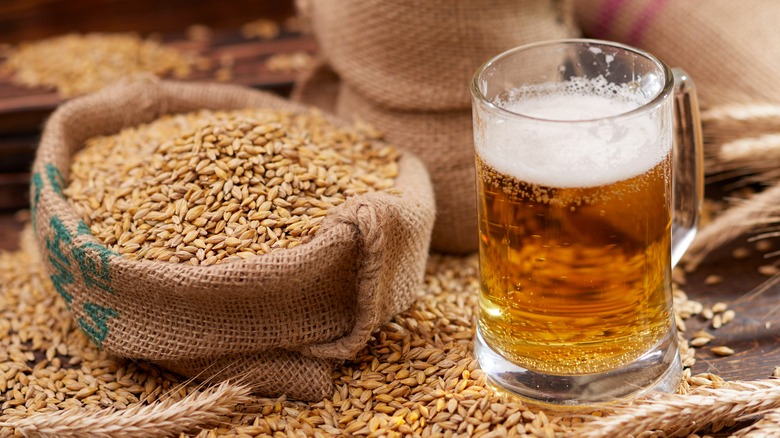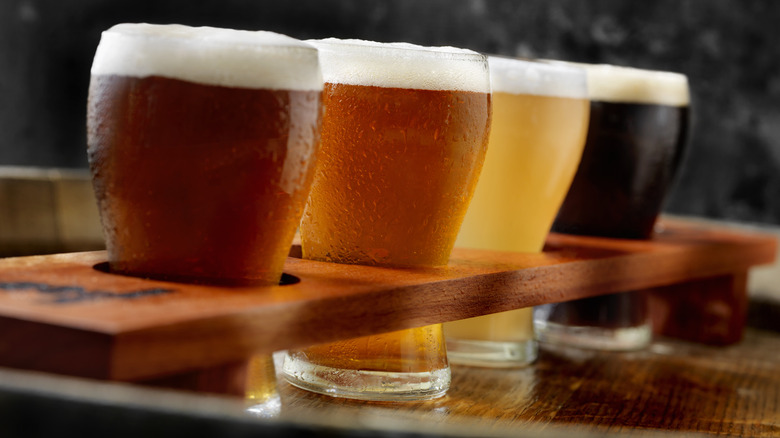Temperature Can Totally Make Or Break The Beer Brewing Process
You dialed in your homebrew recipe and managed to pull off the sparge and chill the wort without accidentally soaking yourself (or your brewing space). All the hard parts are done, and it's smooth sailing until bottling, right? Not if your fermentation temperatures are off.
Yeast is a living thing; it's what turns wort into beer, and it responds differently to different conditions. When yeast gets too cold, it goes dormant, and fermentation stops. When yeast gets too hot, it creates different flavors, or esters, particularly fruity ones. It can also stop producing ethanol — the alcohol type that's typical in beer — and start producing fusel alcohols like propanol and butanol; these types of alcohol are what give your booze a sharp burn. Off-track fermentation temperatures can have your beer tasting all wrong from unwanted flavors even if your recipe is spot on.
Kara Taylor, the yeast lab manager of White Labs, told the American Homebrewers' Association how different temperatures can produce different flavors in the same recipe: "When it's fermented at a lower temperature, the floral, fruity, spicy character of the saison is lower. When that saison is allowed to ferment higher or at room temperatures, we see a fruity, floral, bubblegum aroma." Depending on what you're going for, temperature can be a flavor tool at times. In a different strain, like an English ale yeast, Taylor says a too-hot fermentation can produce nail polish aromas and flavors. Much less pleasant to drink, and evident of improperly-managed temperatures.
What temperature should beer ferment at?
Temperature is so important that it's one of the main defining factors between an ale and a lager. There are three stages where temps need to be managed carefully: Pitching (adding the yeast), primary fermentation, and secondary fermentation, which includes the diacetyl rest stage. It will depend entirely on what beer you're brewing and what yeast you're using.
Pitching temperatures vary depending on what yeast you're using. Lager yeasts should be pitched into cold wort between 46 degrees and 57 degrees Fahrenheit; pilsner 46-54 degrees; ale, wheat, and hefeweizen yeast into wort at 64-72 degrees; Belgian yeast at 68-77 degrees; sour yeast into wort between 70-81 degrees; and saison yeast between 75-84 degrees. Yeast gets to work very quickly after pitching, so getting the temperatures right from the start is critical.
For primary fermentation, ales should be fermented between 62 degrees and 75 degrees Fahrenheit, and lagers should ferment much colder, between 46 degrees and 58 degrees fermentation — unless you break temperature rules completely and make a kolsch instead. Wheat and Belgian-style beers can ferment anywhere between 62 and 85 degrees, depending on the flavors you want to develop with your yeast: Spicy notes or fruity notes.
Secondary fermentation is generally about controlling diacetyl, an unwanted compound produced naturally during fermentation that brewers expel by raising the temperatures 3-4 degrees from the primary fermentation temp. The temperature is then maintained for several days while the yeast absorbs the diacetyl.
How do you control fermentation temperatures?
Maintaining proper fermentation temperatures is critical for the whole fermentation stage, and because the wort will heat up as it ferments, it may require adjustments throughout the process. Controlling your fermentation temperatures can be hard if you're just starting out brewing beer. It's generally going to be warmer than a fridge (and you might not even be able to fit your carboy into the refrigerator) and cooler than ambient living space temperatures. Breweries use special equipment or keep the ambient temperature of fermentation rooms quite cold, but that's probably not reasonable for a home brewer.
If you have an unused fridge, you may be able to hack it to run at the correct temperature. Budget-friendly temperature control measures include water or ice baths and evaporative cooling systems like a wet cloth and fan, but these require frequent monitoring. If you need to keep your beer warm during fermentation, not cold, brewing supply companies sell electric heating wraps that go around your carboy.
If you really aren't in a place to control your fermentation temperatures, try using a compatible strain of yeast. Kara Taylor recommends a Norwegian yeast called "kveik," which includes some strains that are quick fermenting and don't create off-flavors at higher temperatures.


